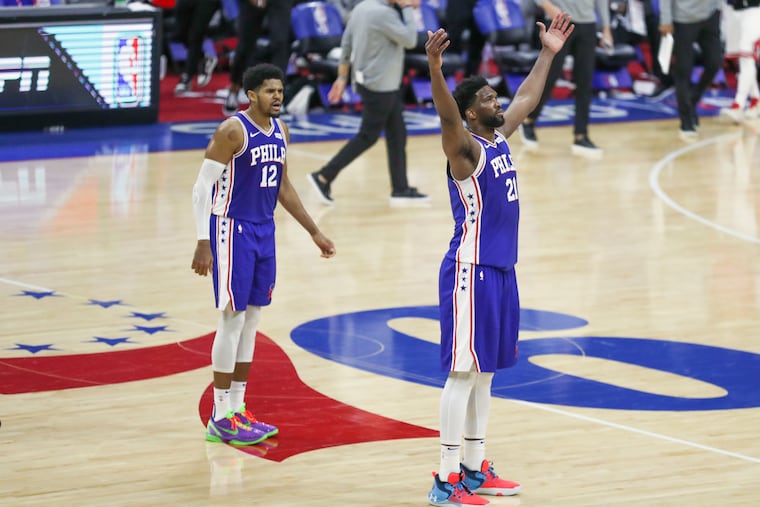Savor Joel Embiid’s performance for the Sixers. And don’t forget the process that led to it. | Mike Sielski
It's easy to forget the chance the Sixers took in drafting Embiid, in waiting for him to get healthy, and in creating so many pitfalls for him along the way.

There’s going to be a rush now, if it hasn’t begun already, to anoint Joel Embiid the NBA’s MVP and the best basketball player in the world, to hold up his game-tying, pump-fake three-pointer Wednesday night against the Jazz as the sort of moment that inspires and justifies those declarations.
It was a marvelous play, saving the Sixers from a loss to the team with the league’s best record and propelling them to a 131-123 overtime victory, and it was only the top highlight in a game full of highlights for Embiid. He had 40 points and 19 rebounds and was marvelous pretty much all night. He is averaging 30.2 points and 11.6 rebounds per game, making 52% of his shots from the field and 42% from three-point range and 86% from the foul line – remarkable shooting figures for a man who is 7 feet tall. If he keeps up that pace and the Sixers (24-12) continue winning at a similar rate and he’s not named the league’s most valuable player this season, it will have taken a hell of a sustained performance to beat him.
There’s no small irony, though, in distilling Embiid’s excellence to a single moment, like that shot against Utah, or even in viewing his season as its own self-contained entity. Long-term memory is often one of the casualties in a social-media society, and Embiid is so good now that it can be easy to forget how fraught and uncertain his future once was, how close he could have come to never suiting up for the Sixers at all. This was never a sure thing. Ever.
» READ MORE: No, Joel Embiid isn’t scared, but he’s missed his share of games against the NBA’s top centers | Keith Pompey
It has been nearly seven years since the Sixers selected Embiid with the No. 3 pick in the 2014 draft, and the only reason that he was available was that he’d had surgery, just six days before the draft, to repair a fracture in the navicular bone in his right foot. That injury contributed to the Cleveland Cavaliers’ decision to take Andrew Wiggins with the first pick and the Milwaukee Bucks’ decision to take Jabari Parker with the second. And it led to a string of long nights inside the Sixers’ headquarters for their power people, then-general manager Sam Hinkie and his staff trying to collect and cross-reference as much information as they could.
“We’d have lots of late-night conference calls where we’d go through all the literature,” Hinkie once said. “We would gather the opinions of the best surgeons around the country, gather the opinions who had evaluated Joel in person, and we tried to keep as much of them independent as we could. ‘This looks like this, and someone else says it looks like this,’ and you’re not sure who to trust. You end up averaging it out over time. In the end, we felt good. It was a calculated risk.”
Had Hinkie and the Sixers passed on Embiid, had they played it safe and drafted Dante Exum or Marcus Smart or Julius Randle, they could have ducked the criticism that came their way over the subsequent two years. Embiid sat out the entire 2014-15 season, which was expected, then, after a setback in the healing of his foot, sat out the entire 2015-16 season, which was not. Hinkie himself never saw a day as the Sixers’ GM with Embiid in the lineup; he resigned in April 2016. Embiid didn’t make his debut until October of that year, and he played just 31 games before a knee injury and the franchise’s caution cut his season short.
» READ MORE: Sixers cap season’s first half with 131-123 OT victory over Jazz
By then, Embiid had consumed several hundred bathtubs worth of Shirley Temples, and his younger brother Arthur had died, and he had admitted to having considered staying at the University of Kansas for another year or two because he had enjoyed college so much. And still ahead were the understandable concerns about his immaturity and oft-poor conditioning, the galatically strange tenures of Bryan Colangelo and Markelle Fultz, the rudderless summer of 2018, and the organization’s backward thinking in the summer of 2019, when it determined that “bully ball” was the best way to build a team in the modern NBA.
In so many ways, until they hired Doc Rivers and Daryl Morey, until they stopped telling everyone they were the smartest people in the room and instead opened their door to the real thing, the Sixers seemed to do everything they could to keep Embiid and themselves from reaching just this point: the best team in the Eastern Conference at the All-Star break, the league’s prospective MVP, twice as many victories as losses, much accomplished, much more to do. That they’re here, though, is a testament to the calculation that Hinkie made back in the spring and early summer of 2014: that in the NBA, a great player can mask all sorts of errors and sins from the past and in the present.
The Sixers have gotten a lot wrong since then, but in drafting Joel Embiid, waiting for Joel Embiid, and relying on Joel Embiid, it looks more and more like they got their most consequential call right. What we’re all seeing from him now, the physical condition he’s in, the skills he’s displaying, the season he’s having, that shot Wednesday night that took everyone’s breath away: All of this was possible, and none of it was assured. Savor it, and the process required to achieve it.